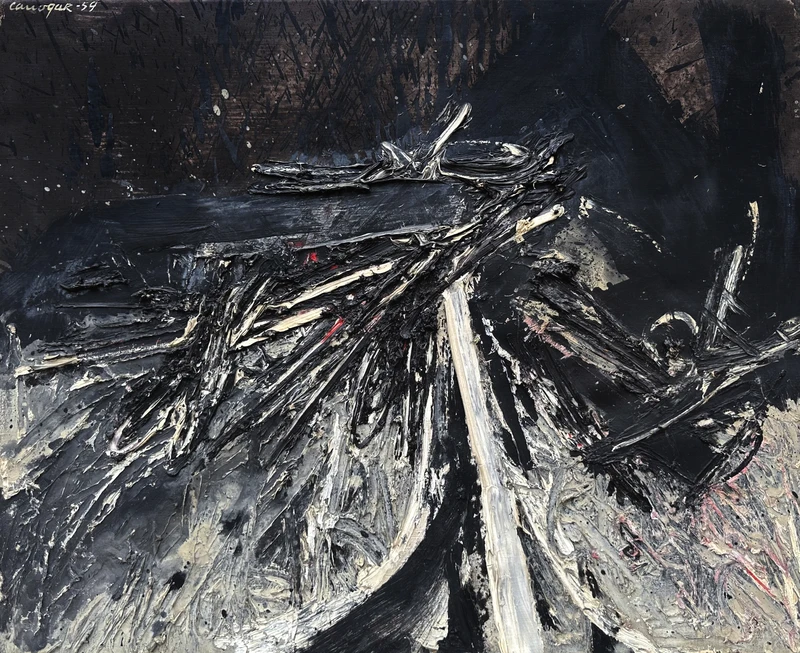Rafael Canogar: Imprints (1958 - 1963)
5 Jun-25 Jul 2025
PV 4 Jun 2025, 6-8pm


Rafael Canogar (born 1935) is one of the leading Spanish artists of the post-war era. He first came to prominence in Madrid in the late-1950s as a founder member of the El Paso group amidst an era of conservatism, social conformity and oppression under General Franco. There, in conjunction with other young artists such as Manolo Millares, Antonio Saura, and Manuel Rivera, Canogar was responsible for creating a provocative and radically new, gestural language of abstract painting that gave fierce, visceral expression to a dynamic sense of energy and individual freedom. These were paintings that, like Wols in France, Emil Schumacher in Germany or Alberto Burri in Italy, immediately established Canogar as one of the foremost pioneers of Informalist painting in Europe.
From these dramatic beginnings, Canogar’s work has, over the last seventy years, continued to evolve through a wide variety of different styles and media; each transformation reflecting a similarly impulsive and vivid personal response to the changing and often difficult times through which he has lived. Organised in partnership between the Mayor Gallery, London and the Guillermo de Osma Gallery in Madrid, Rafael Canogar –Imprints (Paintings 1958 -1962) is an exhibition comprising fourteen landmark paintings from the early, ‘Informalist’ period (1958-62) when Canogar first made his name.
Our art started as an answer to the needs of that time,’ Canogar has said of these years, ‘with the will to transform the art world and make it dynamic, with [pictures] that were at the same time a protest - violent, daring and mystical.’ Inspired initially by the primordial, semi-abstract realities of Paul Klee’s work and then also by the more impulsive, contemporary example of 1950s American Action painting, Canogar’s first ‘Informalist’ pictures were dramatic explorations of the expressive possibilities of matter and gesture. As in such pictures as, Jacque, Pintura, and Untitled of 1959, for example, his work took the form of an often vigorous and aggressive type of abstraction in which the presentation of matter, freed from its use as a medium for representation, was transformed into an evocative subject all of its own.
Here, the thick, earthy, matter of oil paint has been expressively worked into violent and explosive new forms by the artist, using his fingers to trace furrows of feeling and channels of impulsive physical action into and across their surfaces. Often both visceral and traumatic, the stark polarities of these predominantly black and white pictures seem imbued, like so much Spanish art, with a fusion of the twisted pain and suffering of martyrdom and the balletic violence and grace of the corrida. While Canogar has acknowledged that many of these works inevitably look back to the ‘profound roots of feeling present in the paintings of Zurbarán, Velázquez and Goya’ they are also reminiscent, for him, of the ordinary ploughman’s toil with the earth. Indicative too of the innate relationship between matter and spirit, Canogar’s paintings are, above all, material expressions of the inherently physical, body orientated way in which man - even the modern man of a technological age - is condemned to experience reality.
‘Painting,’ Canogar has said of these works ‘that was a spontaneous and physical action, where moods were expressed through gesture. It was the gesture of the subconscious, an unrepeatable expression made with a direct and spontaneous calligraphy. These were eminently intuitive and passionate works, executed with the urgency and spontaneity that the time, the age, and its theories demanded. In Informalism, for me, at least, there was something substantial and mystical, a self-affirmation and self-realization, as well as a break with formal, rational structures and aestheticizing certitudes.’
Seeking what he once called ‘not the ordering of the chaotic moment, but a union with reality itself in an essential contradiction between the explicable and the inexplicable,’ Canogar was attempting through the gestural act and its physical interaction with matter to give expressive form to the individual’s ability to both affect and be affected by the great, universal forces at work in the world. At once both an exultation and a cry of individual freedom, therefore, these, still startling, paintings are dynamic material embodiments of what the poet Frank O’Hara meant when he wrote in the catalogue of their first showing at New York’s Museum of Modern Art in 1960 that it was ultimately ‘through the cultural needs of his society that the artist expresses himself. - Robert Brown, 2025
Canogar has participated in countless collective and solo exhibitions in prestigious museums all over the world, including, most notably, the National Museum of Contemporary Art (1971), the National Library (1982), the Musée d’Art Moderne de la Ville de Paris (1975), the Sonia Heine Foundation in Oslo (1975), the Lund Konsthalle (1975), the Paris Art Centre (1987), the Bochum Art Museum (1988), the Istituto di Storia dell’Arte, Parma (1971), the Bilbao Museum of Fine Arts (1990) and the Reina Sofía Museum (MNCARS) (2001). His works are on display in numerous museums and collections worldwide, including the MNCARS in Madrid, the MoMA in New York, the Pasadena Art Museum, California, the Hamburg Kunsthalle, the Rufino Tamayo Museum in Mexico City, the Museum of Art and History in Geneva and the Ateneum Art Museum in Helsinki, CentroCentro Cibeles Palace in Madrid. The Rafael Canogar Space was inaugurated in Toledo in 2024.